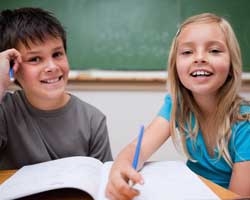Improve Concentration in Children With ADHD With These 5 Activities

Children with attention deficits need effective tools that boost their ability to focus. Take some time with your child and help him or her develop the tools he or she needs, through brain-boosting activities and habits. Engage with your child in a variety of fun exercises that will help him concentrate and also enhance his brain’s cognitive capacity. You can also create systems that strategically assist your child’s organizational skills and increase his academic performance. Here are five ways you can help improve the symptoms of your child’s ADHD:
Play “Freeze Focus”
“Freeze Focus” will increase your child’s awareness and focus. It’s a game you can play anywhere, anytime. When with your child, unexpectedly exclaim, “Freeze! Focus!” From this command, she’ll react with a stand-still of movement for 10 seconds, and will focus her attention on her surroundings. In her frozen state, quiz your child—ask her to describe three things she saw while frozen. Place useful signs, rules and lists of chores around your home so your child can focus on those when she plays the game.
Brain Games and Puzzles
Play games with your child that will help improve concentration. You can play a visual tracking game, where he must sit in a stationary position. You move an object around him horizontally and vertically. This game can be presented through magic tricks or in a silly manner—whichever method keeps him the most engaged. The Coin Game is another game that helps sequencing, memory, concentration and attention. Choose a variation of five coins from a pile and place them into a pattern. Cover the pattern with a sheet of paper or cloth, and have your child recreate the pattern with his own set of coins. You can make it a timed game for added excitement. Crossword and picture puzzles are fun games that increase sequencing and enhance the attention for words. Create a customized crossword puzzle with the names of places, characters and other elements from his favorite book or movie. This game will be encouraging, as he’ll already be familiar with the names and terms, but will also test his concentration.
Physical Activity
Regular physical activity can decrease the symptoms of ADHD. Dr. Betsy Hoza—professor of psychology at the University of Vermont—found that kids that had a half hour of moderate or vigorous exercise, on a daily basis, experienced an increase in focus and mood. All of the kids in the study displayed a decrease of ADHD symptoms. The Centers for Disease Control and Prevention recognizes exercise as a positive combatant against anxiety and stress—both of which can enhance ADHD symptoms. The CDC states that exercise can improve academic performance, as children will have increased concentration and attentiveness.
Reliable Routines
Children with ADHD may also lack strong organizational skills. Your child’s executive function deficits will affect their management of time and deadlines. Create organized systems within your home that require daily use. Have a check-in board, where your child can keep track of her tasks and homework. The board can be a to-do list that your child must check off after completion of each task. Don’t overwhelm her with tasks, but create measurable goals that she can achieve. Also create a visual, daily schedule, that explicitly lists an itinerary of activities for each day—i.e. Wake-up time, brushing teeth, shower, dressing for school, breakfast and school departure. Then she can reference the daily timetable so she can stay on track with their routine.
Electronic Use
Screen time can limit the cognitive development—the construction of information processing, intelligence, reasoning, language development and memory—of your child’s brain. Too much time on a smartphone, on a tablet or in front of a television may rewire your child’s brain. Screen time will idle the centers in the prefrontal cortex, which causes a decrease in their focus and slowing of their processing capabilities. Limit your child’s screen time to an hour per day. Help your child find entertainment alternatives that access their creative centers or increase their physical activity.




